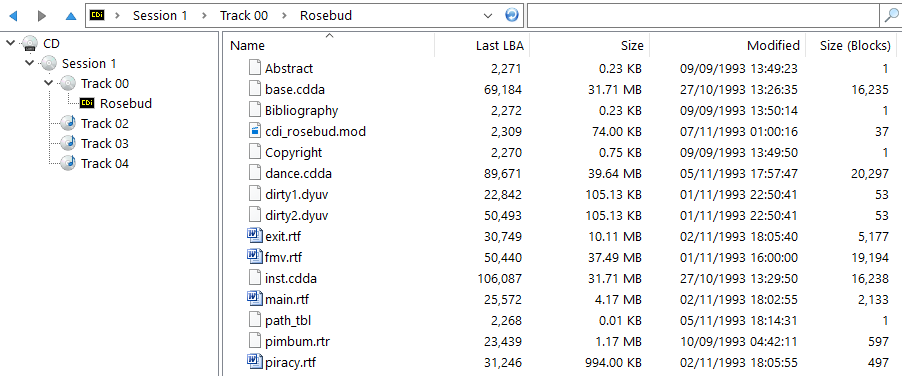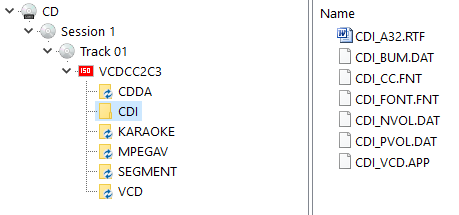CD-i and VCD formats
CD-i
If you really want to know just about anything there is to know about CD-i ... Check out : http://www.cdinteractive.co.uk/forum/ Or : http://www.icdia.co.uk
CD-i is an old Philips Standard and is actually called CD Interactive. CD-i discs were made for the CD-i consoles and are according to the 'Green book' standard.
Because CD-i discs were designed to play only on CD-i players, deviations from normal CD standards were allowed. The new standard was called 'Green book'. The TOC on a CD-i disc does not contain an entry for the data track(s). Only audio tracks can be in the TOC. Consequence is that not many CD/DVD-ROM drives see a track on the CD-i disc and if they do they often get the start address and length wrong. IsoBuster however tries to compensate for that but if the drive (because the TOC is not right) refuses to do anything or read right or whatever still recognizing problems can occur. Therefore it's often a good idea to try and read the CD-i disc in more than one system. Some drives do it better than others.
If the CD-i disc does only contain data tracks you have the best chance of being able to mount the media and browse the content. If there are audio tracks on the CD-i it will get extremely difficult to find a drive which is able to read the CD-i correctly. Reason for this is that the data track is not in the TOC but the audio tracks are, so almost all CD/DVD-ROM drives consider the CD-i to contain audio only (so in fact an audio CD). Trying to read data from an audio CD is then not allowed by the units. Still it depends a bit on the layout (some CD-i discs are finalized as CD-i (then it might still work) but often they are actually as CD-ROM/CDDA discs so that they can play on standard audio players also).
With CD-i recognition there are no guarantees and it will certainly not improve as the format is long 'dead' (Some might disagree ;-)) so modern CD/DVD-ROM drives don't tend to support it anymore.
The File System is also different on a CD-i disc.
For more about that, check out : File Systems.
A lot of 'Video CDs' were created in this Green book (CD-i) standard. These Video CDs are not according to the White Book standard which became THE Video CD standard. So, these CD-i Video CDs don't tend to work on PC (for all the reasons above) but IsoBuster tends to be able to get to the content because in most cases the CD-i discs are finalized as CD-i and the contain Data only. These CD-i Video Discs do tend to work in standalone Video CD players.
If you extract the mpg from a whitebook VCD 2.0, the mpg will be accepted by all VCD creating Write Software. If you extract mpg that is not conform VCD 2.0 (e.g. from a CD-i), a lot of VCD creating apps will complain. However, some of them still allow you to create a VCD from the stream (Yippee) (e.g. WinOnCD, Adaptec VCD Creator 4.0).
Downside is that CD-i players check for CD format and then determine how the mpg format should look like. Resultantly, the CD-i player will most likely freeze on this kind of mpg on a CD-ROM. HOWEVER ... The whole intention of converting to CD-ROM is for the benefit of being able to view the mpg on PC ... And PC Mpg decoding soft has NO problem with this !!
So, you are now able to 'back-Up' all your favorite CD-i movies to CD-ROMS that can be seen by Windows.

VCD
VCD or Video CD is a standard designed for Video content on CD, playable in standalone VCD players (The ones you place under you Television set). The standard is called 'White book'. White book VCDs are not to be mistaken for Green book Video CDs.
VCDs are completely compatible with normal data CDs and the content should be easily accessible. The File System on these CDs should be ISO9660 although occasionally one finds them with a Joliet File System (in addition to ISO9660) also.
VCD CDs contain a fixed file and directory layout. A CDI folder with content so that the VCD can be played in CD-i consoles as well and an MPEGAV folder containing the actual Video File (a *.DAT file). This *.DAT file references data which is located in the second (and higher tracks if available). The second and higher data tracks on VCDs contain the actual Video data, mainly in M2F2 sectors which can be interleaved with M2F1 sectors.
So, if the File System is corrupt and one can't find the Video (*.dat) file, 'Extraction of the Mpg data only' from the second or higher tracks is still possible via IsoBuster. IsoBuster features great and proven recovery functionality for this kind of situations.
